Finite-Time Controller for Coordinated Navigation of Unmanned Underwater Vehicles in a Collaborative Manipulation Task
Abstract
1. Introduction
1.1. Background
1.2. Related Work
1.3. Contributions
2. Materials and Methods
2.1. Unmanned Underwater Vehicle Model
2.1.1. Kinematic Model
2.1.2. Hydrodynamical Model
- a.
- The inertia matrix satisfies with and denoting the minimum and maximum eigenvalues of , respectively;
- b.
- The Coriolis and centripetal vector satisfies ;
- c.
- The damping vector satisfies ;
- d.
- The vector of restoring forces satisfies the following .
2.2. Model-Free High Order Sliding Mode Control
2.2.1. The Feedback Gain α(t)
2.2.2. Stability Analysis
2.3. BlueROV2 Vehicle
- The vehicle travels at relatively low speeds (i.e., less than two m/s) so that the buoyancy forces can be neglected;
- The vehicle’s center of gravity (CG) is assumed to be at the intersection of the planes of symmetry;
- The pitch orientation θ is assumed to be passively stable since the vehicle’s thruster allocation does not allow active control of this DoF.
3. Validation Setup
3.1. Design of the Task
- A water tank of is considered the working space. It is considered clear of obstacles or entities other than the two BlueROV2 and the object to manipulate;
- The initial position for the BlueROV2 vehicles is irrelevant for control and does not affect the convergence time;
- An ideal abstract model of the object to be manipulated is considered. Its physical and dynamic properties are neglected;
- The position of the object is known beforehand;
- Grasping the object is considered solved since it is out of the scope of this work. The grasping occurs when the vehicles reach their respective grasping positions;
- The vehicles grasp the object from opposite sides, i.e., they should align their orientations to face each other and maintain a distance of ;
- There is no communication between the vehicles;
- Interval 1:
- Approach: The vehicles start from an arbitrary initial position and approach the object. The initial position of the object is provided by . The vehicles reach a position above with a distance of in the y-axis measured from their Body-fixed-frame origin. The x-axis coordinate corresponds to the corresponding grasp point. The final orientations of the vehicles are provided by and ;
- Interval 2:
- Descending: The vehicles descend to ;
- Interval 3:
- Grasping: The vehicles move slowly along the y-axis and reach their respective grasping points. Grasping of the object takes place;
- Interval 4:
- Lifting: The vehicles rise to to lift the object from the bottom of the water tank;
- Interval 5:
- Transporting: The vehicles coordinately move the object to a position above the releasing point, defined as ;
- Interval 6:
- Descending: The vehicles lower the object at its final position ;
- Interval 7:
- Release: The vehicles release the object and move on the y-axis to gain a slight separation from it;
- Interval 8:
- Ascending: The vehicles move to to gain separation from the object;
- Interval 9: ;
- Return: The vehicles move to their home positions at opposite corners of the water tank.
3.2. State-of-the-Art Finite-Time Controllers
3.2.1. Non-Singular Terminal Sliding Mode Control
3.2.2. Finite-Time Second-Order Sliding Mode Control
3.3. Further Considerations
3.3.1. External Disturbances
3.3.2. Saturation Constraints
4. Results and Discussions
4.1. Results without Introducing External Disturbances
4.2. Simulations with External Disturbances
5. Conclusions and Future Work
- Implementing an object identification algorithm;
- Implementing an autonomous path planning algorithm;
- Implementing an autonomous object grasping method;
- Including the physical and geometrical parameters of the object;
- Implementing a method for the localization of the vehicle inside a swimming pool;
- Implementing obstacle avoidance algorithms;
- Implementing an auxiliary control algorithm to deal with vehicle-to-vehicle disturbances.
Supplementary Materials
Author Contributions
Funding
Institutional Review Board Statement
Informed Consent Statement
Data Availability Statement
Acknowledgments
Conflicts of Interest
References
- Chen, H.-H.; Chuang, W.-N.; Wang, C.-C. Vision-Based Line Detection for Underwater Inspection of Breakwater Construction Using an ROV. Ocean Eng. 2015, 109, 20–33. [Google Scholar] [CrossRef]
- Khojasteh, D.; Kamali, R. Design and Dynamic Study of a ROV with Application to Oil and Gas Industries of Persian Gulf. Ocean Eng. 2017, 136, 18–30. [Google Scholar] [CrossRef]
- Cieslak, P.; Ridao, P. Adaptive Admittance Control in Task-Priority Framework for Contact Force Control in Autonomous Underwater Floating Manipulation. In Proceedings of the 2018 IEEE/RSJ International Conference on Intelligent Robots and Systems (IROS), Madrid, Spain, 1–5 October 2018; pp. 6646–6651. [Google Scholar] [CrossRef]
- Ribas, D.; Ridao, P.; Turetta, A.; Melchiorri, C.; Palli, G.; Fernandez, J.J.; Sanz, P.J. I-AUV Mechatronics Integration for the TRIDENT FP7 Project. IEEE/ASME Trans. Mechatron. 2015, 20, 2583–2592. [Google Scholar] [CrossRef]
- González-García, J.; Gómez-Espinosa, A.; Cuan-Urquizo, E.; García-Valdovinos, L.G.; Salgado-Jiménez, T.; Escobedo Cabello, J.A. Autonomous Underwater Vehicles: Localization, Navigation, and Communication for Collaborative Missions. Appl. Sci. 2020, 10, 1256. [Google Scholar] [CrossRef]
- Anderlini, E.; Parker, G.G.; Thomas, G. Control of a ROV Carrying an Object. Ocean Eng. 2018, 165, 307–318. [Google Scholar] [CrossRef]
- Soylu, S.; Proctor, A.A.; Podhorodeski, R.P.; Bradley, C.; Buckham, B.J. Precise Trajectory Control for an Inspection Class ROV. Ocean Eng. 2016, 111, 508–523. [Google Scholar] [CrossRef]
- Campos, E.; Chemori, A.; Creuze, V.; Torres, J.; Lozano, R. Saturation Based Nonlinear Depth and Yaw Control of Underwater Vehicles with Stability Analysis and Real-Time Experiments. Mechatronics 2017, 45, 49–59. [Google Scholar] [CrossRef]
- Guerrero, J.; Torres, J.; Creuze, V.; Chemori, A.; Campos, E. Saturation Based Nonlinear PID Control for Underwater Vehicles: Design, Stability Analysis and Experiments. Mechatronics 2019, 61, 96–105. [Google Scholar] [CrossRef]
- Wang, Y.; Zhang, M.; Wilson, P.A.; Liu, X. Adaptive Neural Network-Based Backstepping Fault Tolerant Control for Underwater Vehicles with Thruster Fault. Ocean Eng. 2015, 110, 15–24. [Google Scholar] [CrossRef]
- Ferreira, C.Z.; Cardoso, R.; Meza, M.E.M.; Ávila, J.P.J. Controlling Tracking Trajectory of a Robotic Vehicle for Inspection of Underwater Structures. Ocean Eng. 2018, 149, 373–382. [Google Scholar] [CrossRef]
- Karkoub, M.; Wu, H.M.; Hwang, C.L. Nonlinear Trajectory-Tracking Control of an Autonomous Underwater Vehicle. Ocean Eng. 2017, 145, 188–198. [Google Scholar] [CrossRef]
- Hernández-Alvarado, R.; García-Valdovinos, L.G.; Salgado-Jiménez, T.; Gómez-Espinosa, A.; Fonseca-Navarro, F. Neural Network-Based Self-Tuning PID Control for Underwater Vehicles. Sensors 2016, 16, 1429. [Google Scholar] [CrossRef] [PubMed]
- Chu, Z.; Xiang, X.; Zhu, D.; Luo, C.; Xie, D. Adaptive Trajectory Tracking Control for Remotely Operated Vehicles Considering Thruster Dynamics and Saturation Constraints. ISA Trans. 2020, 100, 28–37. [Google Scholar] [CrossRef]
- Zhang, M.; Chu, Z. Adaptive Sliding Mode Control Based on Local Recurrent Neural Networks for Underwater Robot. Ocean Eng. 2012, 45, 56–62. [Google Scholar] [CrossRef]
- Slotine, J.J.; Li, W. Applied Nonlinear Control; Prentice-Hall: Englewood Cliffs, NJ, USA, 1991. [Google Scholar]
- Yu, H.; Guo, C.; Yan, Z. Globally Finite-Time Stable Three-Dimensional Trajectory-Tracking Control of Underactuated UUVs. Ocean Eng. 2019, 189, 106329. [Google Scholar] [CrossRef]
- Qiao, L.; Zhang, W. Adaptive Second-Order Fast Nonsingular Terminal Sliding Mode Tracking Control for Fully Actuated Autonomous Underwater Vehicles. IEEE J. Ocean. Eng. 2019, 44, 363–385. [Google Scholar] [CrossRef]
- Li, J.; Guo, H.; Zhang, H.; Yan, Z. Double-Loop Structure Integral Sliding Mode Control for UUV Trajectory Tracking. IEEE Access 2019, 7, 101620–101632. [Google Scholar] [CrossRef]
- García-Valdovinos, L.G.; Fonseca-Navarro, F.; Aizpuru-Zinkunegi, J.; Salgado-Jiménez, T.; Gómez-Espinosa, A.; Cruz-Ledesma, J.A. Neuro-Sliding Control for Underwater ROV’s Subject to Unknown Disturbances. Sensors 2019, 19, 2943. [Google Scholar] [CrossRef]
- García-Valdovinos, L.G.; Salgado-Jiménez, T.; Bandala-Sánchez, M.; Nava-Balanzar, L.; Hernández-Alvarado, R.; Cruz-Ledesma, J.A. Modelling, Design and Robust Control of a Remotely Operated Underwater Vehicle. Int. J. Adv. Robot. Syst. 2014, 11, 1729–8814. [Google Scholar] [CrossRef]
- Mofid, O.; Mobayen, S. Adaptive Sliding Mode Control for Finite-Time Stability of Quad-Rotor UAVs with Parametric Uncertainties. ISA Trans. 2018, 72, 1–14. [Google Scholar] [CrossRef]
- Mofid, O.; Mobayen, S.; Zhang, C.; Esakki, B. Desired Tracking of Delayed Quadrotor UAV under Model Uncertainty and Wind Disturbance Using Adaptive Super-Twisting Terminal Sliding Mode Control. ISA Trans. 2022, 123, 455–471. [Google Scholar] [CrossRef] [PubMed]
- Rojsiraphisal, T.; Mobayen, S.; Asad, J.H.; Vu, M.T.; Chang, A.; Puangmalai, J. Fast Terminal Sliding Control of Underactuated Robotic Systems Based on Disturbance Observer with Experimental Validation. Mathematics 2021, 9, 1935. [Google Scholar] [CrossRef]
- Deng, X.; Wei, L. Adaptive Neural Network Finite-Time Control of Uncertain Fractional-Order Systems with Unknown Dead-Zone Fault via Command Filter. Fractal Fract. 2022, 6, 494. [Google Scholar] [CrossRef]
- Li, Y.; Niu, B.; Zong, G.; Zhao, J.; Zhao, X. Command Filter-Based Adaptive Neural Finite-Time Control for Stochastic Nonlinear Systems with Time-Varying Full-State Constraints and Asymmetric Input Saturation. Int. J. Syst. Sci. 2022, 53, 199–221. [Google Scholar] [CrossRef]
- Guerrero, J.; Torres, J.; Creuze, V.; Chemori, A. Trajectory Tracking for Autonomous Underwater Vehicle: An Adaptive Approach. Ocean Eng. 2019, 172, 511–522. [Google Scholar] [CrossRef]
- Qiao, L.; Zhang, W. Double-Loop Integral Terminal Sliding Mode Tracking Control for UUVs with Adaptive Dynamic Compensation of Uncertainties and Disturbances. IEEE J. Ocean. Eng. 2019, 44, 29–53. [Google Scholar] [CrossRef]
- Liu, X.; Zhang, M.; Yang, C.; Yin, B. Finite-Time Tracking Control for Autonomous Underwater Vehicle Based on an Improved Non-Singular Terminal Sliding Mode Manifold. Int. J. Control. 2020, 95, 840–849. [Google Scholar] [CrossRef]
- González-García, J.; Narcizo-Nuci, N.A.; García-Valdovinos, L.G.; Salgado-Jiménez, T.; Gómez-Espinosa, A.; Cuan-Urquizo, E.; Cabello, J.A.E. Model-Free High Order Sliding Mode Control with Finite-Time Tracking for Unmanned Underwater Vehicles. Appl. Sci. 2021, 11, 1836. [Google Scholar] [CrossRef]
- Casalino, G.; Simetti, E.; Manerikar, N.; Sperinde, A.; Torelli, S.; Wanderlingh, F. Cooperative Underwater Manipulation Systems: Control Developments within the MARIS Project. IFAC-PapersOnLine 2015, 28, 1–7. [Google Scholar] [CrossRef]
- Manerikar, N.; Casalino, G.; Simetti, E.; Torelli, S.; Sperindé, A. On Autonomous Cooperative Underwater Floating Manipulation Systems. Proc.—IEEE Int. Conf. Robot. Autom. 2015, 2015, 523–528. [Google Scholar] [CrossRef]
- Simetti, E.; Casalino, G. Manipulation and Transportation with Cooperative Underwater Vehicle Manipulator Systems. IEEE J. Ocean. Eng. 2017, 42, 782–799. [Google Scholar] [CrossRef]
- Peleska, J.; Brauer, J.; Huang, W. Model-Based Testing for Avionic Systems Proven Benefits and Further Challenges. In ISoLA; Margaria, T., Steffen, B., Eds.; Lecture Notes in Computer Science; Springer International Publishing: Cham, Switzerland, 2018; Volume 17, pp. 82–103. ISBN 978-3-540-88478-1. [Google Scholar]
- Krichen, M.; Lahami, M.; Cheikhrouhou, O.; Alroobaea, R.; Maâlej, A.J. Security Testing of Internet of Things for Smart City Applications: A Formal Approach. In EAI/Springer Innovations in Communication and Computing; Springer: Cham, Switzerland, 2020; pp. 629–653. ISBN 9783030137052. [Google Scholar]
- Bhattacharya, S.; Victor, N.; Chengoden, R.; Ramalingam, M.; Selvi, G.C.; Maddikunta, P.K.R.; Donta, P.K.; Dustdar, S.; Jhaveri, R.H.; Gadekallu, T.R. Blockchain for Internet of Underwater Things: State-of-the-Art, Applications, Challenges, and Future Directions. Sustainability 2022, 14, 15659. [Google Scholar] [CrossRef]
- Khoury, J.; Khoury, J.; Zouein, G.; Arnaout, J.P. A Practical Decentralized Access Protocol for Autonomous Vehicles at Isolated Under-Saturated Intersections. J. Intell. Transp. Syst. Technol. Planning, Oper. 2019, 23, 427–440. [Google Scholar] [CrossRef]
- Fossen, T.I. Handbook of Marine Craft Hydrodynamics and Motion Control; John Wiley & Sons, Ltd.: Chichester, UK, 2011; ISBN 9781119994138. [Google Scholar]
- Society of Naval Architects and Marine Engineers. Nomenclature for Treating the Motion of a Submerged Body through a Fluid. Tech. Res. Bull. 1950, 1950, 1–5. [Google Scholar]
- Parra-Vega, V.; Arimoto, S.; Liu, Y.H.; Hirzinger, G.; Akella, P. Dynamic Sliding PID Control for Tracking of Robot Manipulators: Theory and Experiments. IEEE Trans. Robot. Autom. 2003, 19, 967–976. [Google Scholar] [CrossRef]
- Wu, C. 6-DoF Modelling and Control of a Remotely Operated Vehicle. Ph.D. Thesis, Flinders University, Adelaide, Australia, 2018. [Google Scholar]
- Liu, S.; Liu, Y.; Chen, Z.; Liang, X. Finite-Time Tracking Control of Underwater Vehicles with System Uncertainties and Unknown Disturbances. In Proceedings of the 2017 36th Chinese Control Conference (CCC), Dalian, China, 26–28 July 2017; pp. 6581–6585. [Google Scholar] [CrossRef]
- Zhang, Y.; Liu, X.; Luo, M.; Yang, C. MPC-Based 3-D Trajectory Tracking for an Autonomous Underwater Vehicle with Constraints in Complex Ocean Environments. Ocean Eng. 2019, 189, 106309. [Google Scholar] [CrossRef]
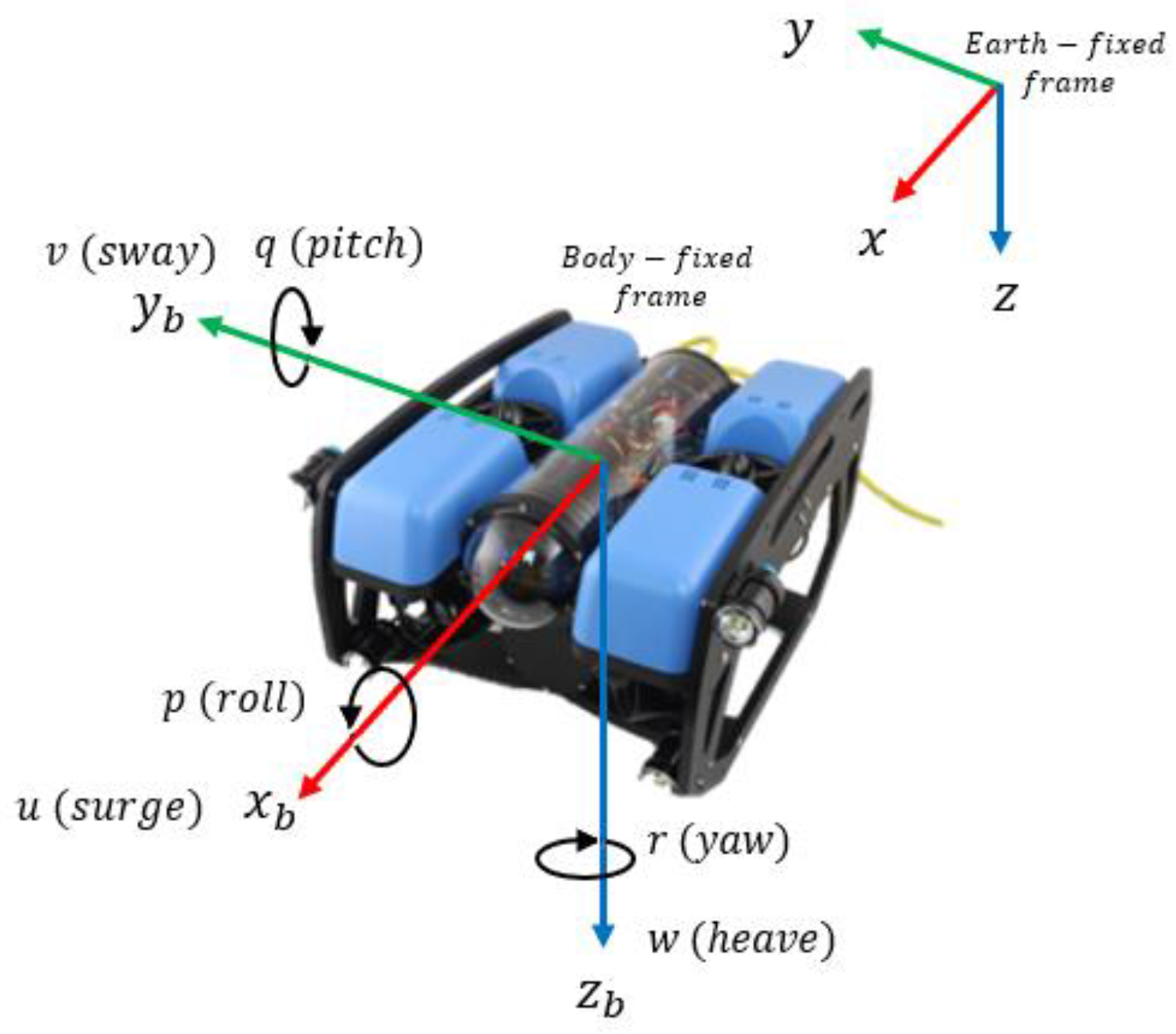
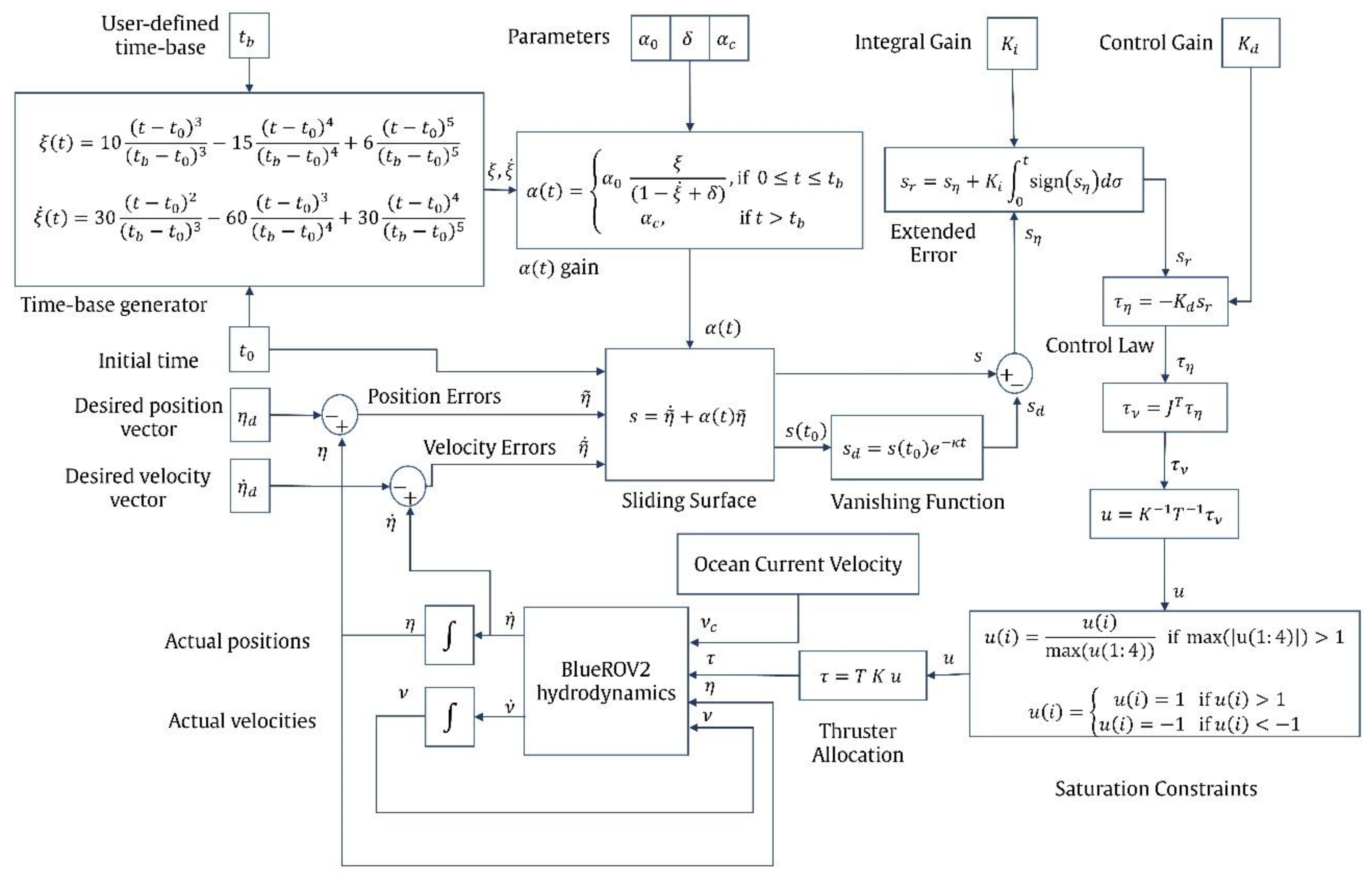

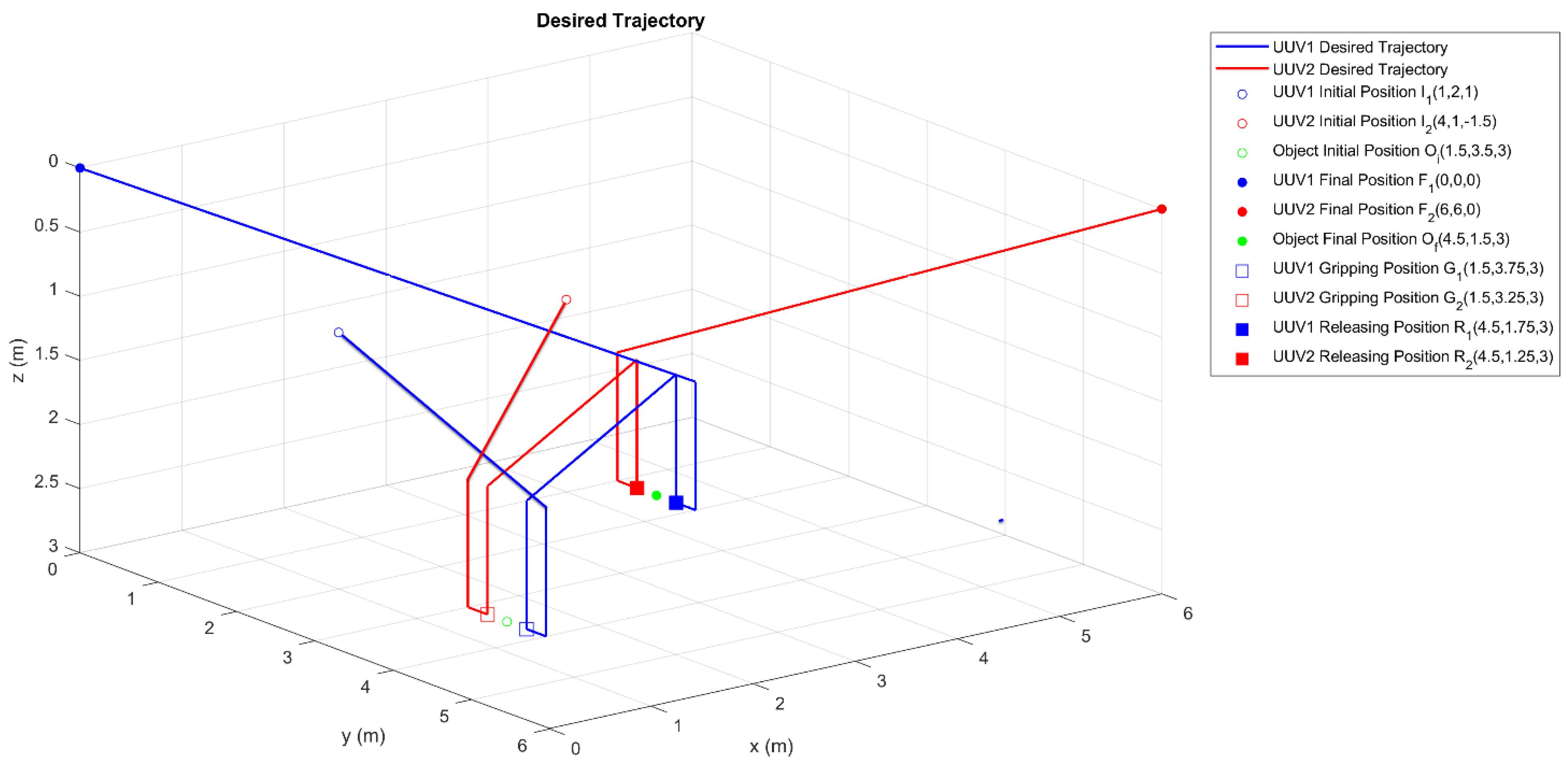


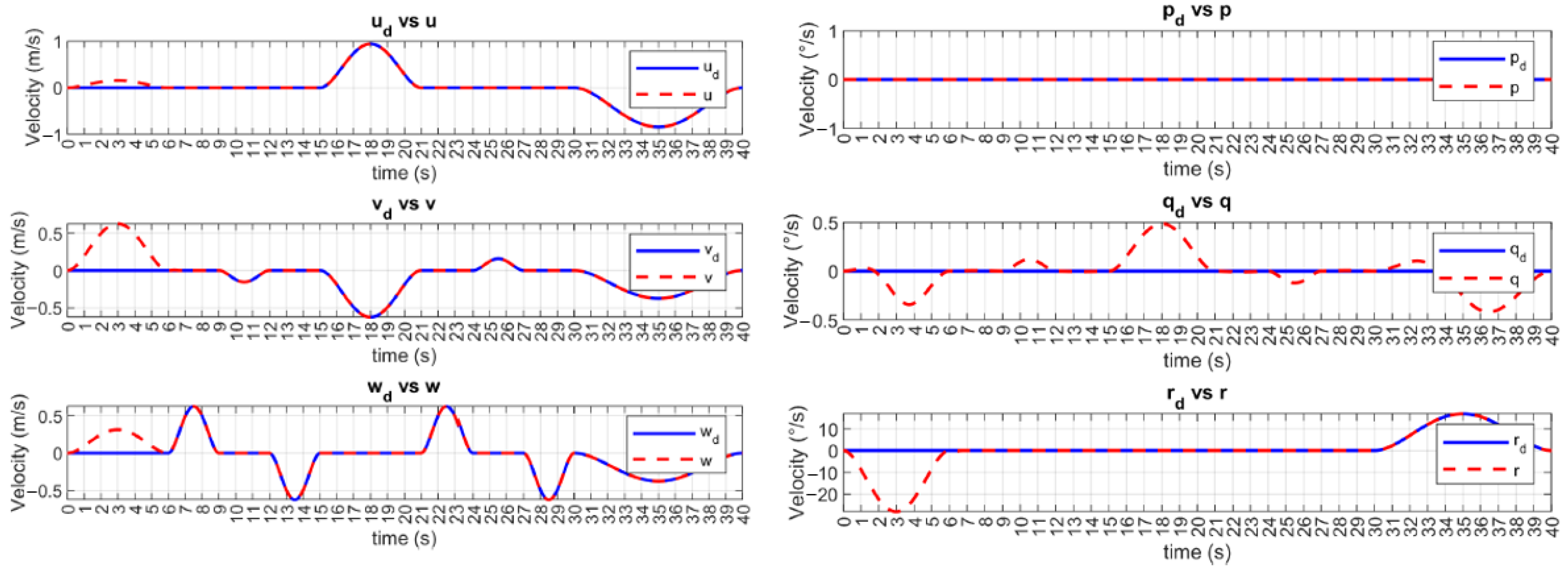
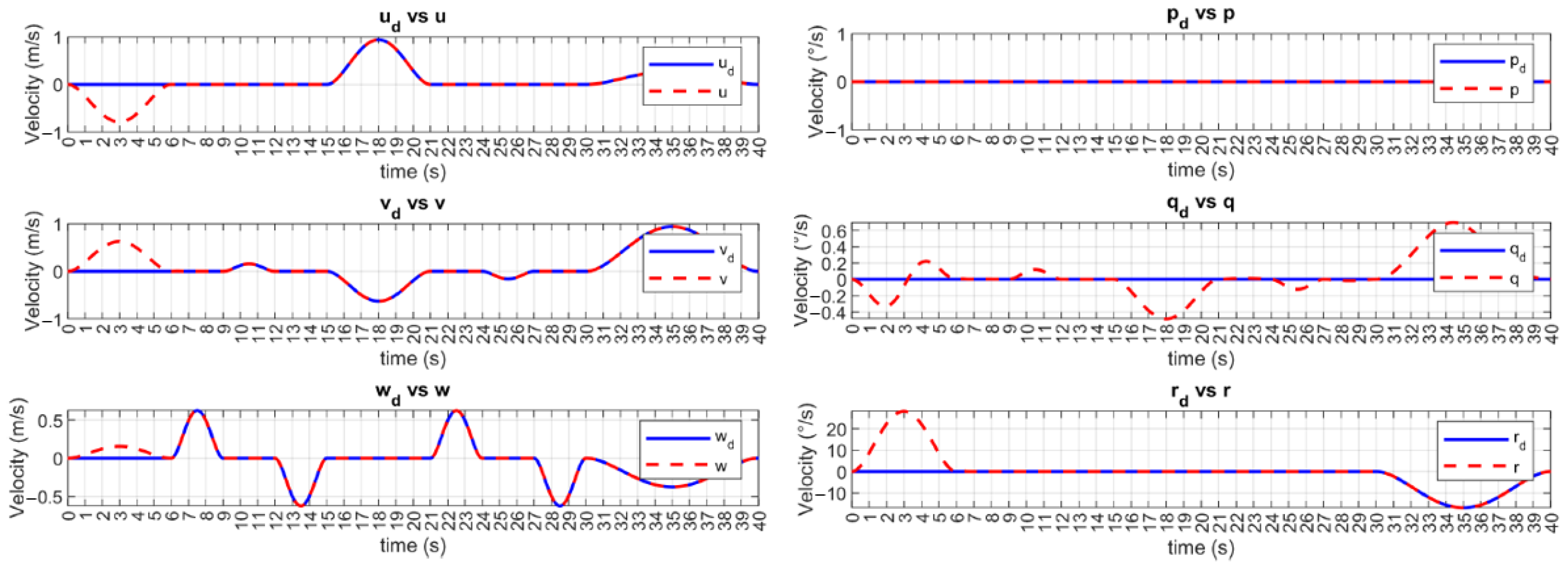
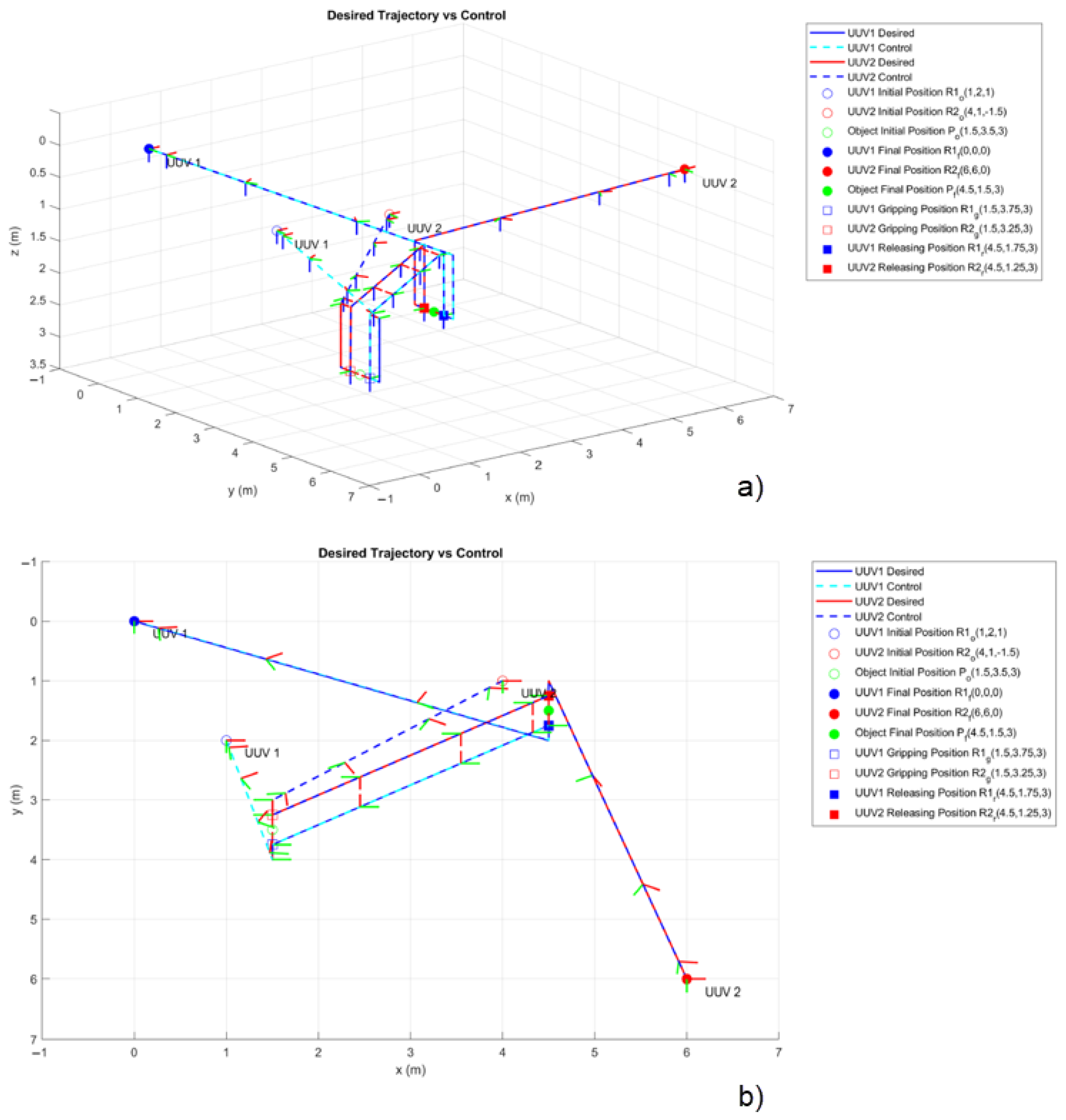
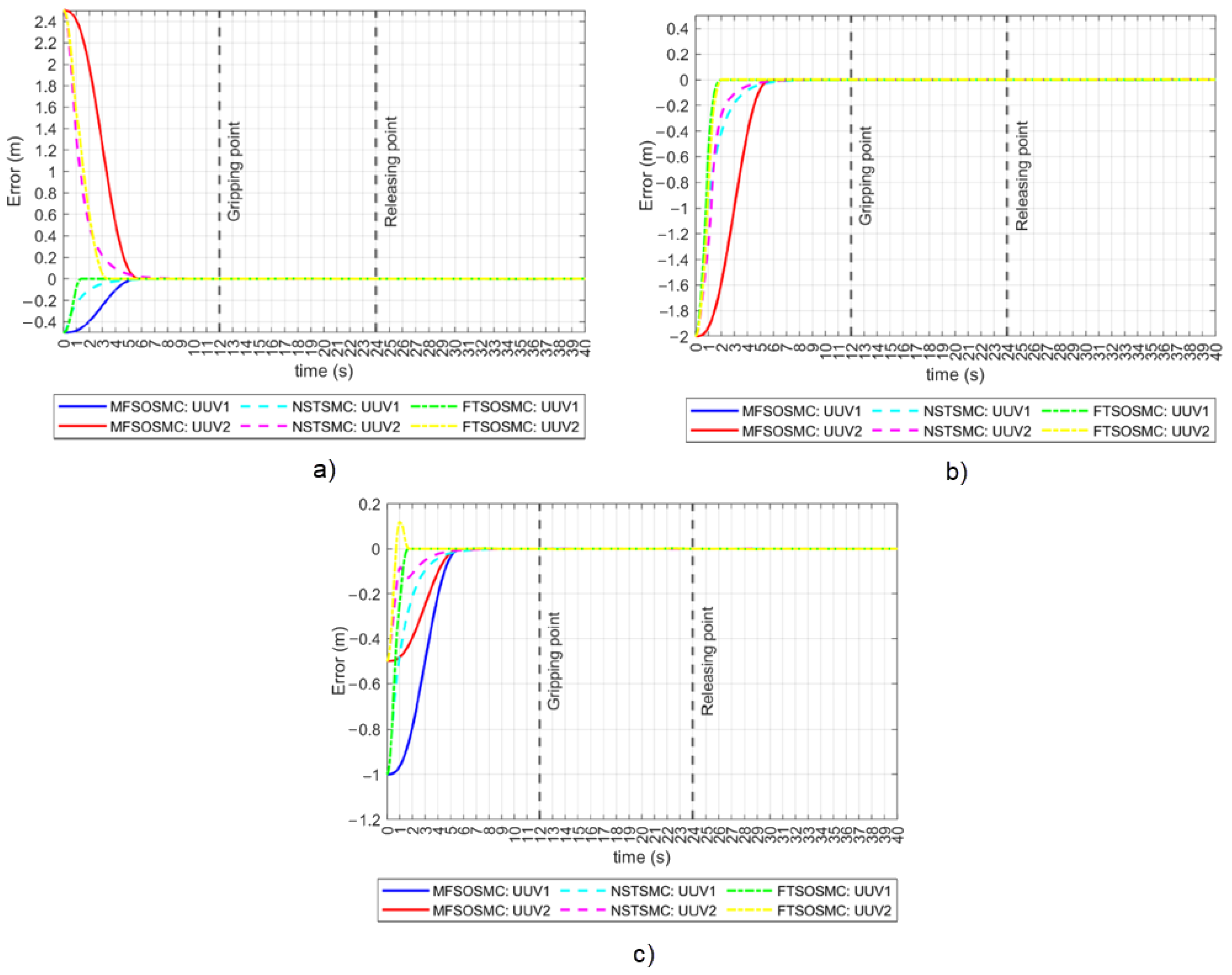
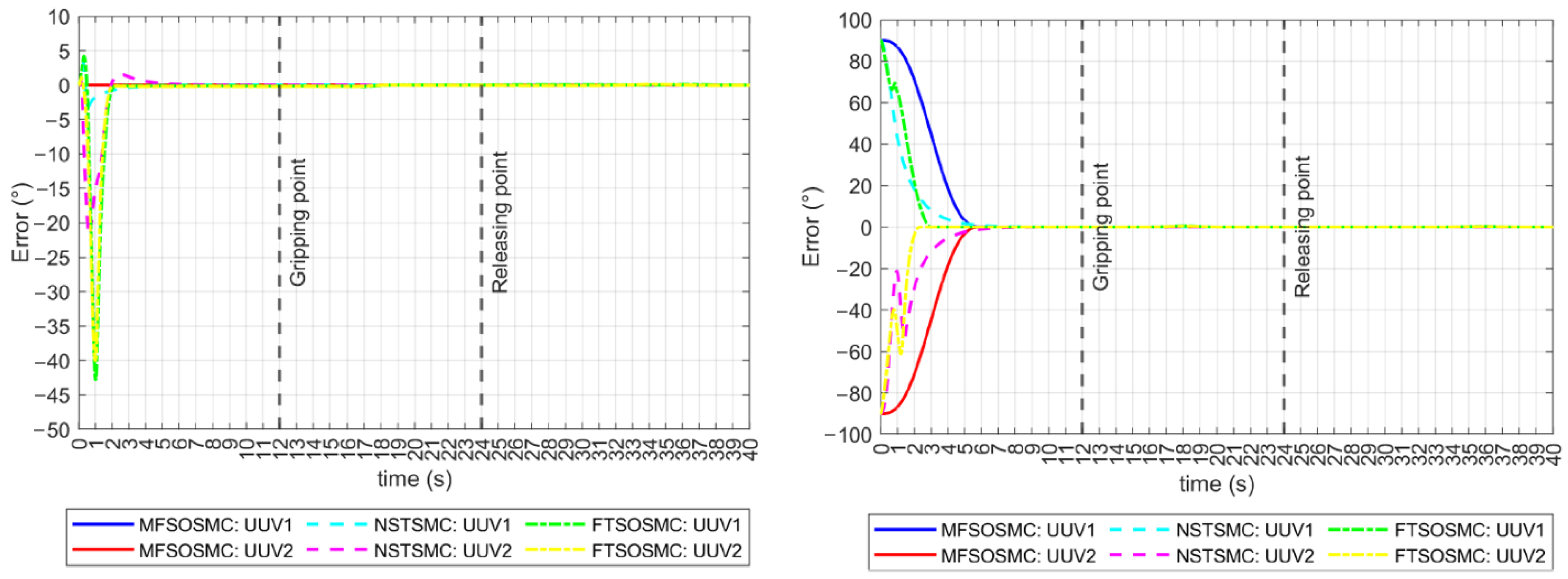
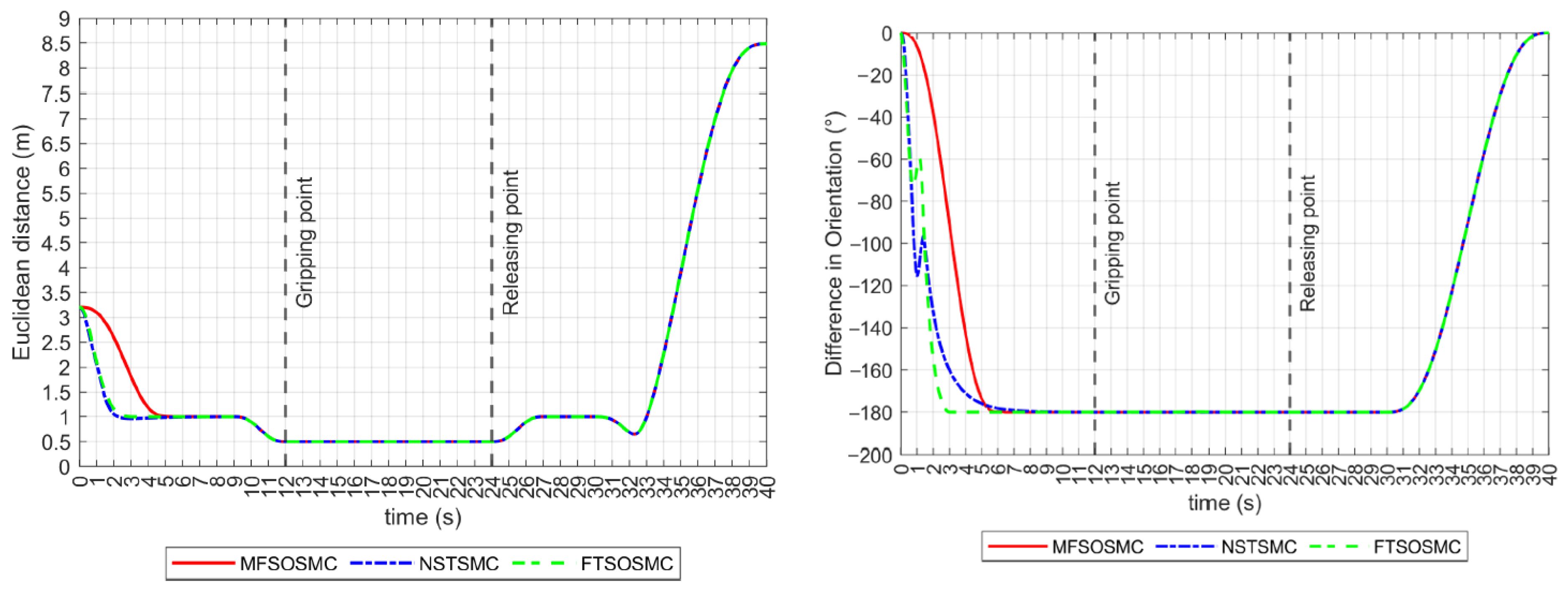

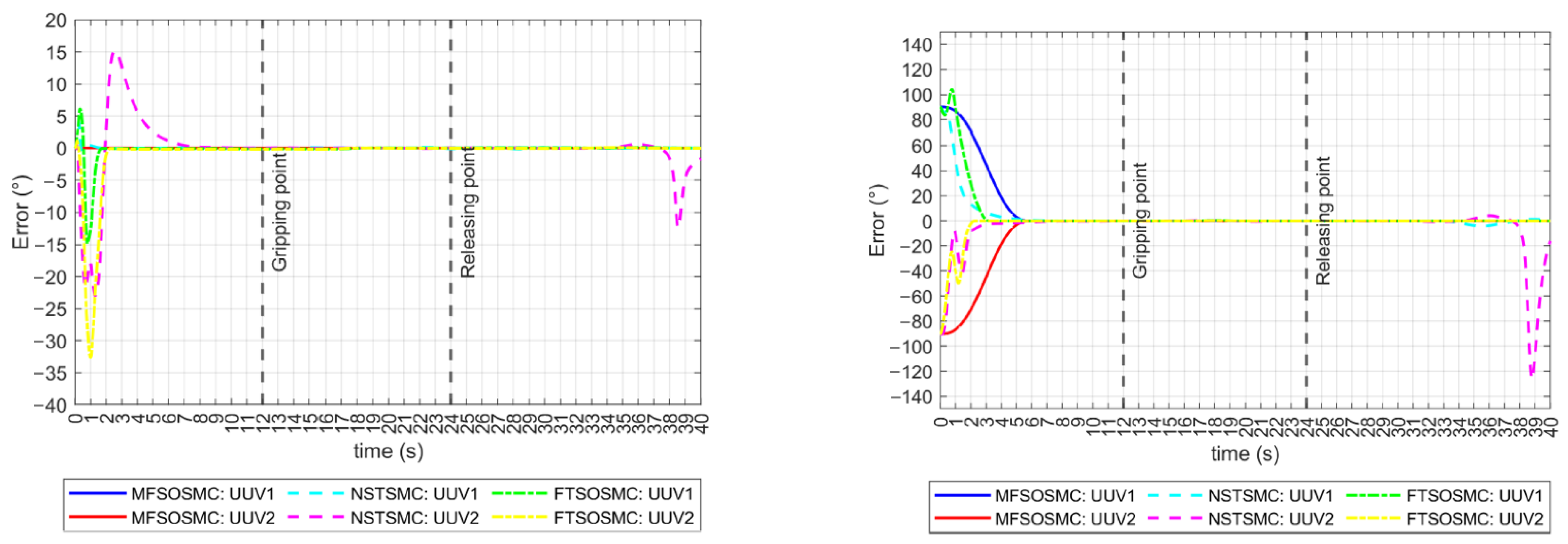
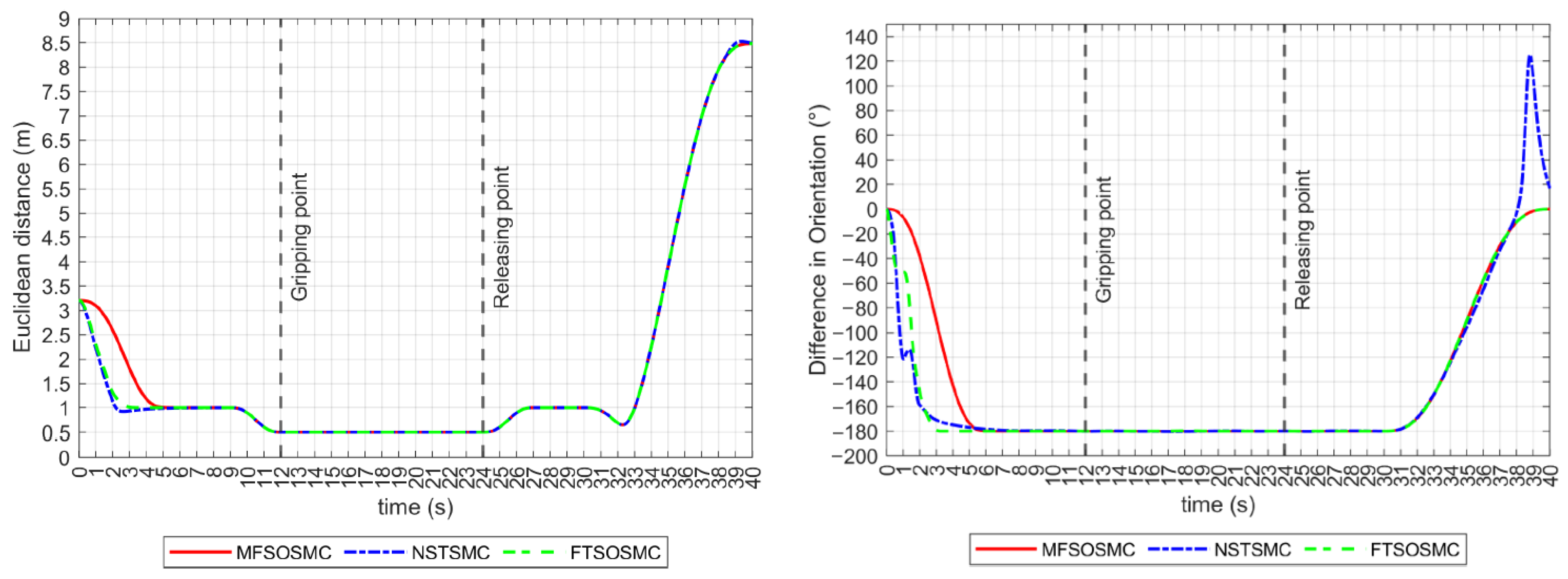
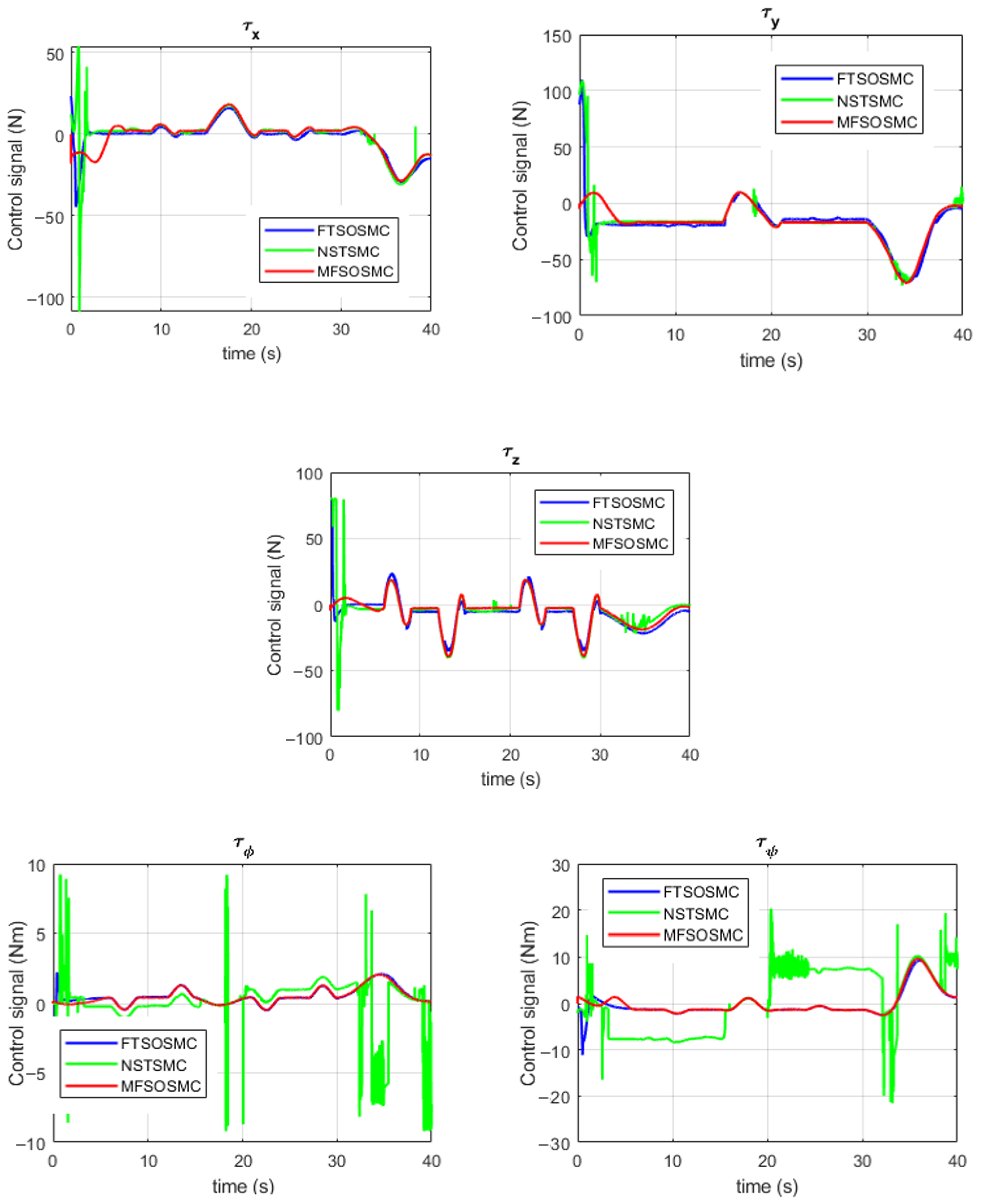
| Name | DoF | Position | Velocity | Force/Moment |
|---|---|---|---|---|
| Surge | X translation | |||
| Sway | Y translation | |||
| Heave | Z translation | |||
| Roll | X rotation | |||
| Pitch | Y rotation | |||
| Yaw | Z rotation |
| Parameter (Unit) | Value |
|---|---|
| Dimensions (mm) | 457 × 338 × 254 |
| Weight in Air (kg) | 11 |
| Net Buoyancy | 0.2 |
| Parameter (Unit) | Value |
|---|---|
| 0.16 | |
| 0.16 | |
| 0.16 |
| Parameter (Unit) | Value |
|---|---|
| −5 | |
| −12.7 | |
| −14.57 | |
| −0.12 | |
| −0.12 | |
| −0.12 |
| Parameter (Unit) | Value |
|---|---|
| −4.03 | |
| −6.22 | |
| −5.18 | |
| −0.07 | |
| −0.07 | |
| −0.07 | |
| −18.18 | |
| −21.66 | |
| −36.99 | |
| −1.55 | |
| −1.55 | |
| −1.55 |
| Controller | Parameters |
|---|---|
| MFSOSMC | , |
| . | |
| NSTSMC | |
| FTSOSMC | |
Disclaimer/Publisher’s Note: The statements, opinions and data contained in all publications are solely those of the individual author(s) and contributor(s) and not of MDPI and/or the editor(s). MDPI and/or the editor(s) disclaim responsibility for any injury to people or property resulting from any ideas, methods, instructions or products referred to in the content. |
© 2022 by the authors. Licensee MDPI, Basel, Switzerland. This article is an open access article distributed under the terms and conditions of the Creative Commons Attribution (CC BY) license (https://creativecommons.org/licenses/by/4.0/).
Share and Cite
González-García, J.; Narcizo-Nuci, N.A.; Gómez-Espinosa, A.; García-Valdovinos, L.G.; Salgado-Jiménez, T. Finite-Time Controller for Coordinated Navigation of Unmanned Underwater Vehicles in a Collaborative Manipulation Task. Sensors 2023, 23, 239. https://doi.org/10.3390/s23010239
González-García J, Narcizo-Nuci NA, Gómez-Espinosa A, García-Valdovinos LG, Salgado-Jiménez T. Finite-Time Controller for Coordinated Navigation of Unmanned Underwater Vehicles in a Collaborative Manipulation Task. Sensors. 2023; 23(1):239. https://doi.org/10.3390/s23010239
Chicago/Turabian StyleGonzález-García, Josué, Néstor Alejandro Narcizo-Nuci, Alfonso Gómez-Espinosa, Luis Govinda García-Valdovinos, and Tomás Salgado-Jiménez. 2023. "Finite-Time Controller for Coordinated Navigation of Unmanned Underwater Vehicles in a Collaborative Manipulation Task" Sensors 23, no. 1: 239. https://doi.org/10.3390/s23010239
APA StyleGonzález-García, J., Narcizo-Nuci, N. A., Gómez-Espinosa, A., García-Valdovinos, L. G., & Salgado-Jiménez, T. (2023). Finite-Time Controller for Coordinated Navigation of Unmanned Underwater Vehicles in a Collaborative Manipulation Task. Sensors, 23(1), 239. https://doi.org/10.3390/s23010239









